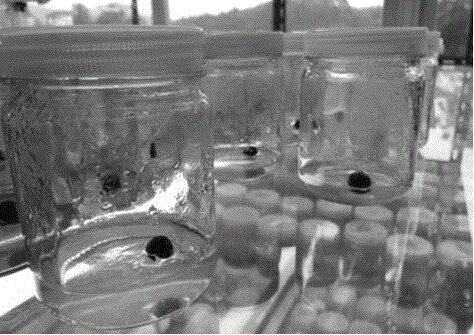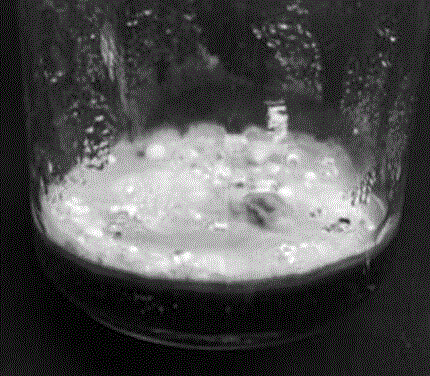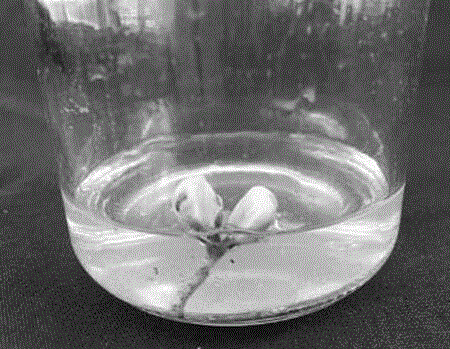Disinfection method for castanopsis hystrix explants
A disinfection method and explant technology, applied in the field of plant tissue culture, can solve the problems of endogenous bacteria pollution, pollution problem loss, incomplete disinfection of explants, etc. Effect
- Summary
- Abstract
- Description
- Claims
- Application Information
AI Technical Summary
Benefits of technology
Problems solved by technology
Method used
Image
Examples
Embodiment 1
[0041] Embodiment 1 seed disinfection method
[0042] 1. Do not remove the outer testa
[0043] After the pre-treatment, the following six methods were used for advanced treatment on the ultra-clean workbench (as shown in Table 1). Each bottle was inoculated with 1 seed, 1 bottle was 1 repetition, and each treatment was 20 bottles ( figure 1 ).
[0044] Table 1 Different seed disinfection methods
[0045]
[0046]
[0047] The results showed that the contamination rate of K1-K3 seeds was as high as 100%, and the disinfection effect was poor, and the contamination rate of K4-K6 was 20%-95%, which was better than that of K1-K3. The test results show that soaking seeds in hot water at 100°C can effectively kill the bacteria on the surface of the seeds and reduce the contamination rate of the seeds.
[0048] The pollution rate of K4 is 90%, and the disinfection effect is not ideal. The pollution rate of K6 seeds is the lowest, only 20%, and the disinfection effect is the b...
Embodiment 2
[0057] The disinfection method of the explant of the stem section of the red cone tree of embodiment 2
[0058] 1. Remove the leaves of the collected branches indoors, soak them in washing powder or disinfectant powder for 20 minutes, rinse them with tap water for 20 minutes, and place them on an ultra-clean workbench after cleaning. Under sterile conditions, cut into 1-2cm long stem segments, each stem segment contains 1 bud point. After being treated with 75% ethanol for 30 seconds, rinse with sterile water 2 to 3 times. Eighteen kinds of disinfection treatment methods were set up for stem section disinfection treatment (Table 3). The sterilized stem section of Rhododendron angustifolia was inserted into the improved MS medium on the ultra-clean workbench, and the oblique insertion method was adopted for inoculation. One stem segment was inoculated per bottle, and 30 were inoculated for each treatment, including 10 lateral bud branches, semi-lignified branches, and 10 south...
Embodiment 3
[0063] Embodiment 3 red cone tissue culture propagation method
[0064] When the method of this paper carries out the tissue culture propagation of the red cone, the explant can choose the seed or the stem segment.
[0065] 1, described red cone tissue culture propagation method comprises the selection of red cone explant, collection, pretreatment, aseptic treatment, specifically comprises the following steps:
[0066] (1) Selection of explants
[0067] According to different research objectives, different explants of seed embryos or stem segments are selected, which generally come from excellent plants with robust growth, no pests and diseases, and high seed setting rate.
[0068] (2) Explant collection
[0069] Seed collection: Collect when the seeds are fully mature from the beginning of December to the end of December, when the fruit involucre and thorns turn from green to brown.
[0070] Collecting stems:
[0071] ①Explant larvae: During the peak growth season of the ...
PUM
 Login to View More
Login to View More Abstract
Description
Claims
Application Information
 Login to View More
Login to View More - R&D
- Intellectual Property
- Life Sciences
- Materials
- Tech Scout
- Unparalleled Data Quality
- Higher Quality Content
- 60% Fewer Hallucinations
Browse by: Latest US Patents, China's latest patents, Technical Efficacy Thesaurus, Application Domain, Technology Topic, Popular Technical Reports.
© 2025 PatSnap. All rights reserved.Legal|Privacy policy|Modern Slavery Act Transparency Statement|Sitemap|About US| Contact US: help@patsnap.com



